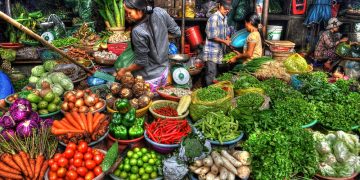Vietnam’s agricultural industry faces a pivotal moment as it navigates the demands of key markets like China and the European Union (EU). The tightening import conditions imposed by China and the rigorous standards set by the EU pose significant challenges for Vietnamese exporters. According to Mr. Tran Thanh Hai, Deputy Director-General of the Import-Export Department (Ministry of Industry and Trade), China, being Vietnam’s largest vegetable export market, continues to tighten its import regulations, necessitating strict compliance from Vietnamese businesses to avoid disruptions in export activities.
Mr. Tô Ngọc Sơn, Deputy Head of the Department of Asian and African Markets (Ministry of Industry and Trade), underscores the importance of retaining traditional markets like China while exploring new ones. Despite Vietnam’s strategic position and potential, there are lingering shortcomings in economic and trade cooperation with China, indicating untapped opportunities for further collaboration.
The Chinese market accounts for a significant portion of Vietnam’s vegetable exports, with Yunnan Province sharing borders with four Vietnamese provinces. However, despite this geographical advantage, economic cooperation between the two sides has yet to reach its full potential, according to representatives from the Ministry of Industry and Trade.
Addressing the challenges in accessing the Chinese market, Mr. Tran Thanh Nam, Deputy Minister of Agriculture and Rural Development, emphasizes the importance of meeting evolving standards. Vietnamese enterprises are urged to adhere to technical requirements, collaborate with local agricultural units to establish raw material areas, and obtain necessary certifications to meet Chinese standards.
While EU markets present immense growth opportunities following the implementation of the EVFTA, Vietnamese vegetable exports to the EU still represent a fraction of the total market demand. Despite Vietnam’s strengths in vegetable production, the country faces hurdles in meeting stringent EU standards, limiting its market share.
Key factors contributing to Vietnam’s limited presence in the EU market include inadequate production areas meeting quality standards, insufficient internationally certified enterprises, and challenges in logistics and packaging. Investments in post-harvest processing technologies and logistical infrastructure are essential to enhance the quality and freshness of Vietnamese produce for distant markets like Europe and the United States.
Mr. Nguyen Dinh Tung, CEO of Vina T&T Group, highlights the importance of advanced harvesting, preservation, and transportation technologies to ensure the quality of Vietnamese vegetables for international markets. Developing robust post-harvest processing and logistics capabilities is essential for meeting stringent market requirements and maintaining competitiveness.
Similarly, Mr. Dang Phuc Nguyen, Secretary-General of the Vietnam Fruit and Vegetable Association, emphasizes the need for scalable production models and widespread adoption of safety standards like VietGAP and GlobalGAP. Despite modest progress in adopting these standards, challenges persist in aggregating large volumes of compliant produce for export contracts.
Vietnam’s agricultural sector stands at a crossroads, balancing challenges posed by evolving market demands with opportunities for growth. To capitalize on these opportunities and overcome challenges, concerted efforts are needed to enhance production standards, invest in post-harvest technologies, and strengthen collaboration between stakeholders across the supply chain. By addressing these imperatives, Vietnam can consolidate its position in existing markets and unlock new avenues for agricultural trade and prosperity.































